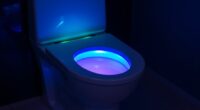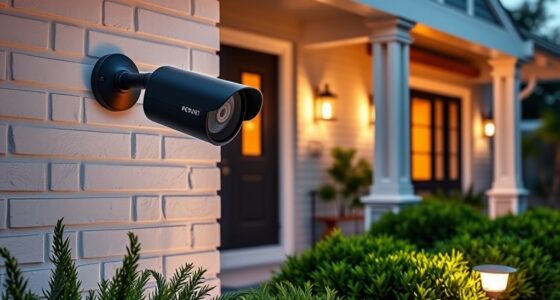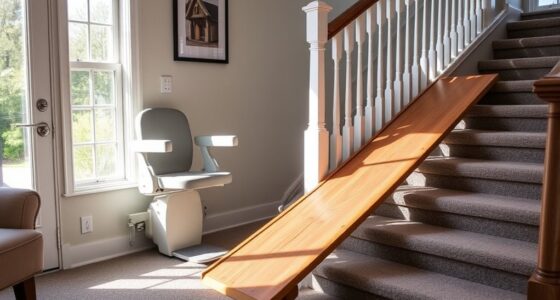To gauge your home safety checklist the right way, systematically evaluate key areas like fire safety, security devices, child and pet protections, indoor air quality, and storage practices. Regularly test alarms, check exits, inspect locks and cameras, and guarantee hazardous materials are stored safely. Conduct routine drills and maintenance to keep everything in check. Staying consistent and thorough helps you identify weaknesses before they become hazards—keep exploring to learn more about maintaining a safer home.
Key Takeaways
- Conduct regular inspections of fire detection, security devices, and emergency exits to ensure proper function.
- Use a comprehensive checklist to evaluate safety features like locks, alarms, and child-proofing measures.
- Test all safety systems periodically, including fire alarms, security cameras, and ventilation, and document results.
- Identify and address hazards for children and pets, securing furniture, outlets, and hazardous materials.
- Maintain organized storage of hazardous substances and perform routine safety drills to prepare for emergencies.
Assessing Fire Safety Measures
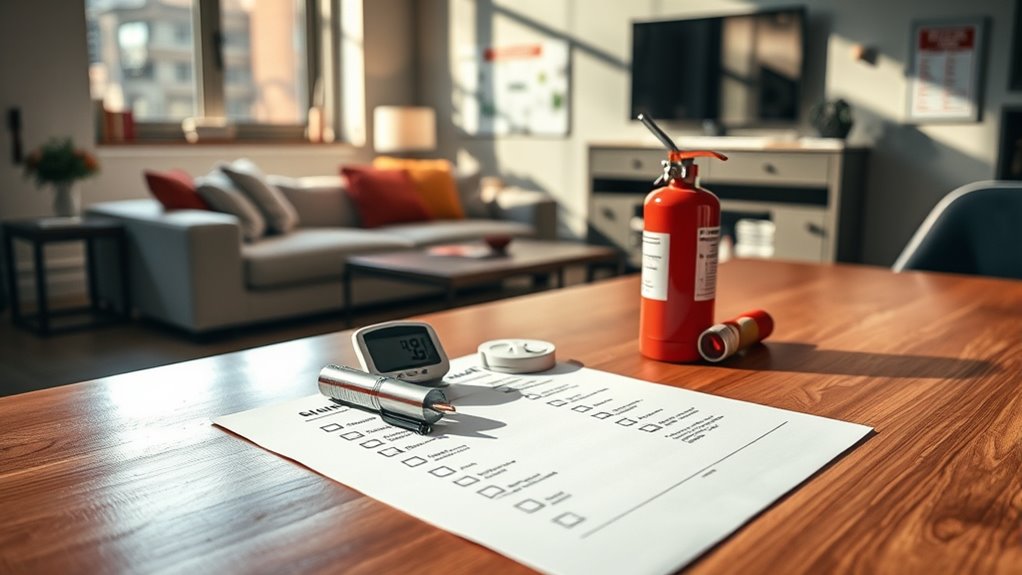
To effectively assess your fire safety measures, start by checking that smoke detectors are installed on every level of your home, especially near bedrooms and in common areas. Regular fire alarm testing guarantees they function correctly, giving you early warning in case of fire. Don’t forget smoke detector maintenance—clean the units regularly and replace batteries at least once a year, or as needed. Testing the alarms monthly helps confirm they’re working properly, while physical upkeep prevents nuisance alerts or failures. If detectors are outdated or malfunctioning, replace them promptly. These simple steps ensure your smoke detection system remains reliable, protecting you and your loved ones from fire hazards. Proper fire alarm testing and smoke detector maintenance are essential for an effective home safety plan. Attention to detail is crucial for identifying potential safety issues before they become serious problems.
Checking Electrical Systems and Outlets
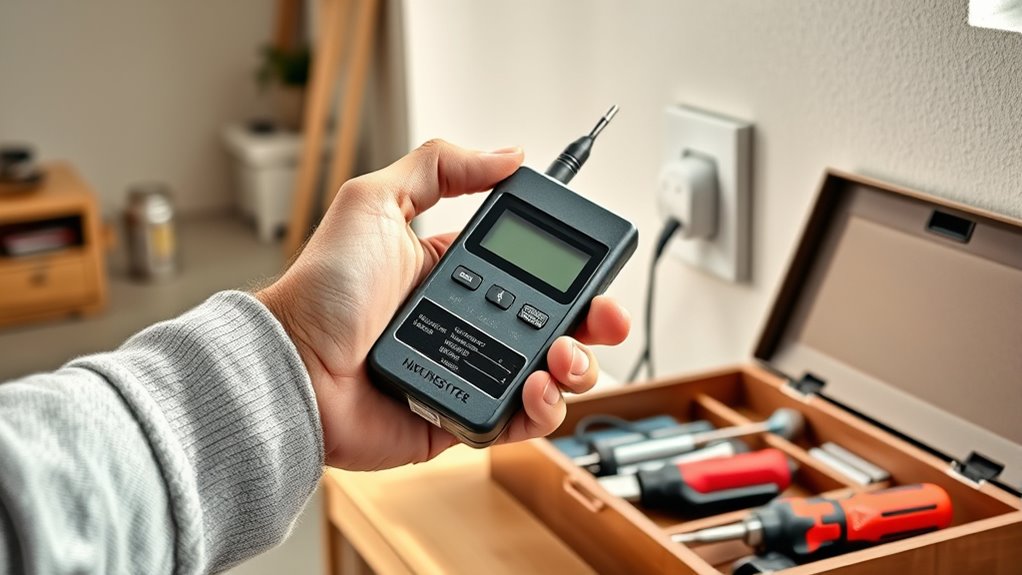
After guaranteeing your fire safety measures are in place, it’s important to turn your attention to your home’s electrical system. Check your circuit breaker to ensure it trips properly and isn’t overloaded. Inspect outlets for signs of damage, such as scorch marks, cracks, or loose covers. Test each outlet with a voltage tester or plug in a small device to confirm it works correctly. Avoid using outlets with poor outlet condition or exposed wiring. Regularly reviewing your system helps prevent electrical hazards. Additionally, ensuring proper color accuracy in your electrical setup can contribute to safer and more efficient operation. Here’s a quick overview:
| Circuit Breaker Check | Outlet Condition | Safety Tip |
|---|---|---|
| Ensure tripping on overload | Look for scorch marks or cracks | Replace damaged outlets immediately |
| Reset if needed | Tighten loose outlets | Avoid overloading circuits |
| Test with a tester | No exposed wiring | Keep outlets free of debris |
| Confirm proper function | No flickering or sparks | Call an electrician for repairs |
Evaluating Emergency Exits and Escape Routes
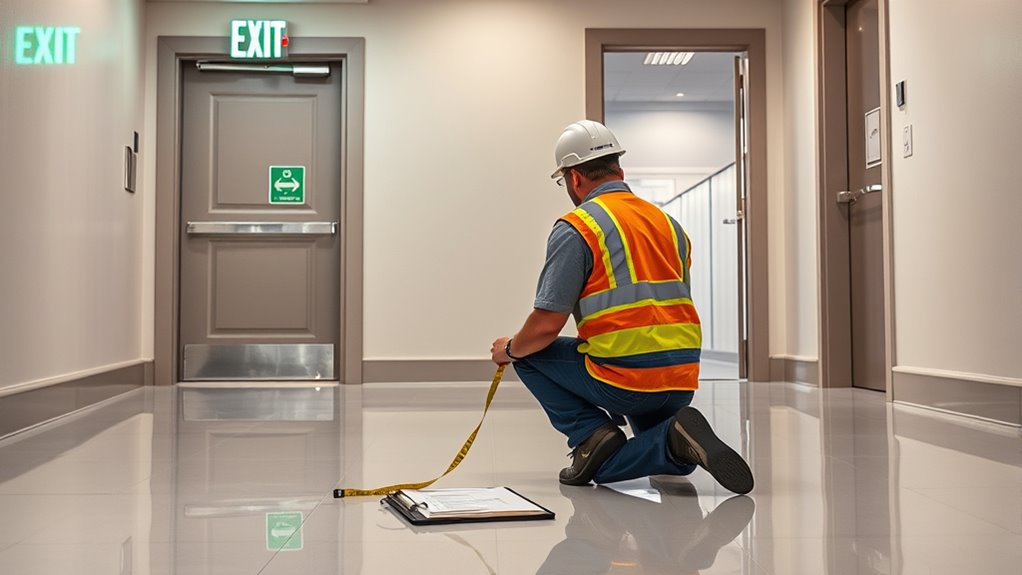
You need to guarantee your emergency exits are easy to find and free of obstructions at all times. Check that pathways are clear and wide enough for everyone, including children and elderly family members. Making your escape routes accessible for all can save precious seconds during an emergency. Regularly inspecting building codes and permits ensures your safety measures comply with local regulations.
Clear Exit Pathways
Have you checked if your emergency exits are easily accessible and free of obstructions? Clear pathways are essential during an emergency, so ensure nothing blocks your fire escape or main exits. Remove furniture, clutter, or any hazards that could slow you down. Verify that exit signage is visible from different angles and well-lit, guiding everyone to safety. Test that doors open smoothly without resistance and that they lead directly outside without unnecessary barriers. Keep pathways wide enough for quick evacuation and regularly inspect for any damage or debris. These steps help prevent delays and confusion during an emergency, ensuring everyone can evacuate swiftly and safely. Remember, a clear exit pathway saves lives—make it a priority in your home safety checklist. Additionally, understanding the value of home security systems can further enhance your safety preparedness.
Accessibility for All
Making certain that emergency exits and escape routes are accessible for everyone is a vital part of home safety. You should evaluate whether your exits follow universal design principles, making them easy to use for people with different abilities. Check that pathways are wide enough for wheelchairs or assistive technology, like stairlifts or grab bars. Remove obstacles that could hinder quick escape, and ensure doors and windows can be easily opened by all residents, including those with limited strength or mobility. Consider installing visual or auditory alarms to alert everyone promptly. Ensuring your custodian services are reliable can also help maintain the safety and security of your emergency routes. By prioritizing accessibility, you create a safer environment where everyone, regardless of physical ability, can evacuate swiftly and safely during an emergency.
Inspecting Home Security Devices
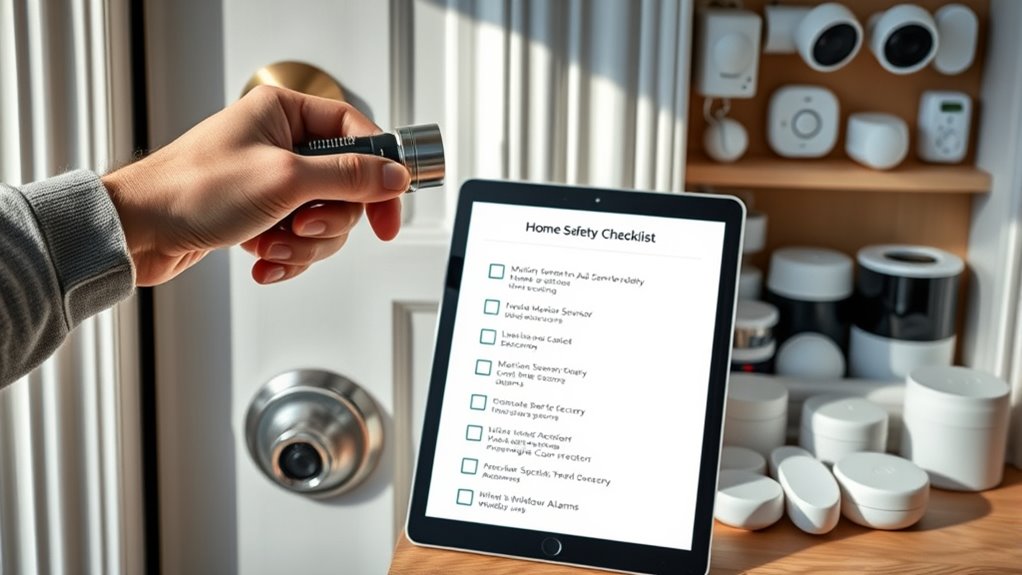
Regularly inspecting your home security devices is essential to maintaining an effective safety system. Check your smart locks to guarantee they lock and unlock properly, replacing batteries if needed. Test your surveillance cameras to verify they’re recording clearly and covering key entry points. Look for any signs of tampering or damage, such as loose wiring or physical obstructions. Confirm that motion detectors and alarm systems are functioning correctly by triggering test alerts. Keep software and firmware updated on digital devices to prevent vulnerabilities. Regular inspections help you identify issues early, ensuring your security devices operate seamlessly when needed. Additionally, understanding home safety benefits can motivate consistent checks, giving you peace of mind, knowing your home’s safety system is reliable and ready to protect you.
Reviewing Child and Pet Safety Precautions
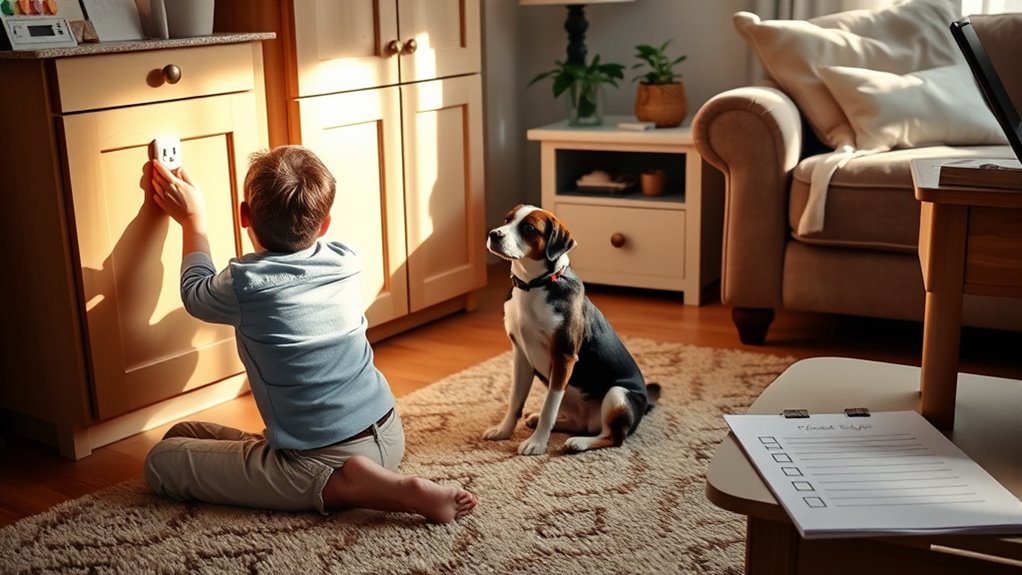
To keep your home safe for children and pets, it’s important to review and implement safety precautions regularly. Start by evaluating your child proofing measures, such as securing furniture, covering outlets, and locking cabinets. Creating pet safe zones helps prevent accidents and keeps your pets away from dangerous areas. Use the table below to evaluate key safety areas:
| Area | Child Proofing Measures | Pet Safe Zones |
|---|---|---|
| Kitchen | Stove knob covers, cabinet locks | Crate or designated pet area |
| Living Room | Corner protectors, secure cords | Pet bed, designated play area |
| Bedrooms | Outlet covers, furniture anchors | Baby gates, pet barriers |
| Bathroom | Toilet lock, medicine cabinet latch | Non-slip mats, designated space |
| Laundry Room | Detergent safety, door locks | Restricted access areas |
Additionally, regularly checking for potential hazards such as loose cords or small objects can further reduce risks.
Monitoring Indoor Air Quality and Ventilation
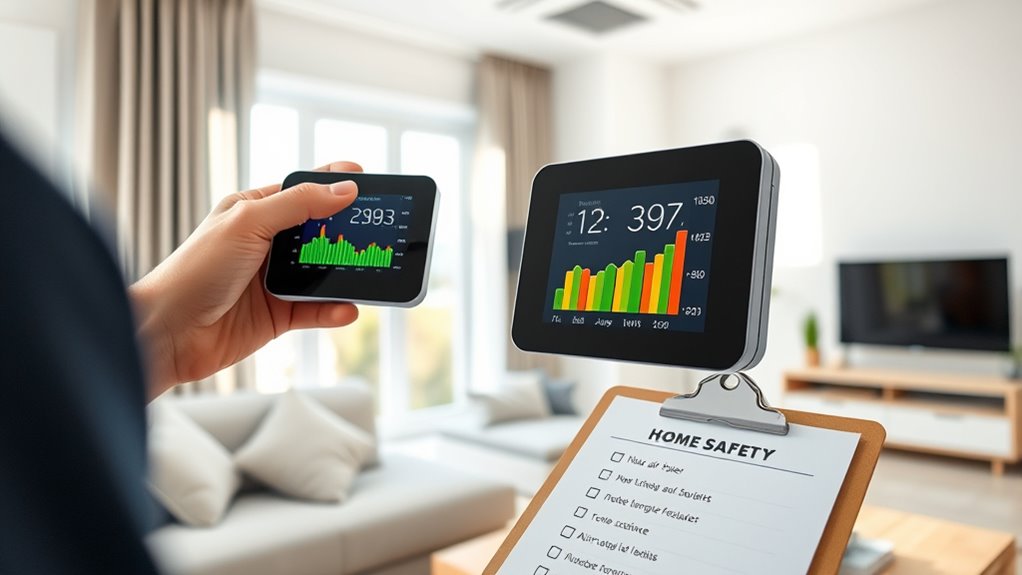
You need to keep an eye on your home’s air quality to guarantee a safe environment. Regularly check pollutant levels, make sure your ventilation system is working effectively, and keep humidity in check. These steps help create healthier indoor air for everyone. Additionally, utilizing advanced air quality sensors can provide real-time data to better manage indoor conditions.
Detecting Pollutant Levels
How can you guarantee your home’s air quality is safe? The key is regularly checking pollutant levels with reliable tools. Install pollutant sensors to detect common indoor pollutants like VOCs, carbon monoxide, or allergens. An air purifier with built-in sensors can also help monitor air quality and reduce pollutants. Use these devices consistently to get real-time data. Additionally, understanding Special Occasions related to health and safety can encourage regular maintenance and vigilance, ensuring a healthier indoor environment. Here’s a quick guide:
| Device Type | What it Does |
|---|---|
| Pollutant Sensors | Detect specific pollutants and alert you to risks |
| Air Purifier | Improves air quality and monitors pollutant levels |
| Monitoring App | Tracks and displays air quality data over time |
Ensuring Proper Ventilation
Monitoring indoor air quality goes hand in hand with maintaining proper ventilation. You want to guarantee there’s enough air exchange to keep the air fresh and safe. Check your ventilation systems regularly—they should operate efficiently and without obstruction. Open windows and doors whenever possible to promote natural airflow, especially during activities that produce pollutants. Consider installing exhaust fans in bathrooms and kitchens to remove excess moisture and contaminants. Use air purifiers with HEPA filters if needed, but remember their effectiveness depends on proper ventilation. Proper airflow reduces indoor pollutants, prevents mold growth, and improves overall air quality. Regularly evaluating your ventilation setup helps you identify issues early, keeping your home healthier and safer for everyone inside.
Monitoring Humidity Levels
Keeping an eye on indoor humidity levels is essential for maintaining a healthy home environment. Humidity sensors are a simple way to monitor moisture levels accurately, helping you identify when humidity is too high or low. Excess moisture can lead to mold growth, pests, and respiratory issues, so moisture control is vital. By regularly checking humidity levels, you can prevent these problems before they escalate. Aim to keep indoor humidity between 30% and 50%, adjusting with dehumidifiers or humidifiers as needed. Proper ventilation also plays a role in maintaining balanced humidity. Using humidity sensors helps you stay informed, allowing you to take quick action to improve air quality and protect your home’s safety. Monitoring humidity levels is a key step in creating a healthier living space. Incorporating air purifiers with HEPA filters can further improve indoor air quality by reducing airborne allergens and pollutants that thrive in high humidity environments.
Ensuring Proper Storage of Hazardous Materials
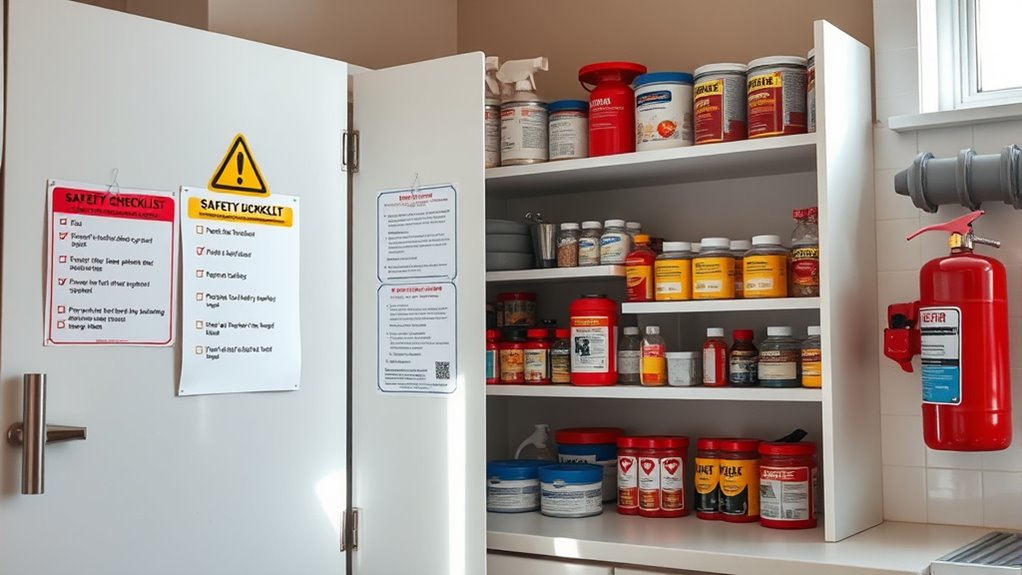
Are you confident that your hazardous materials are stored safely? Proper storage of these substances is crucial for home safety. Focus on effective chemical storage and strict labeling practices to prevent accidents. Make certain chemicals are kept in a well-ventilated, secure area away from heat or flames. Use clearly visible labels to identify contents and hazards, including expiration dates. Store incompatible chemicals separately to avoid dangerous reactions. Regularly inspect storage areas for leaks, corrosion, or damage. Keep lids tightly sealed and containers upright. Maintain an organized system that allows quick access during emergencies. Proper chemical storage and accurate labeling minimize risks, protect your household, and ensure compliance with safety standards. Understanding tableware materials can also help in identifying safe storage options for certain items. Taking these steps creates a safer environment for everyone at home.
Conducting Routine Maintenance and Safety Drills

Regular maintenance of your home’s safety features and practicing safety drills help make certain that everyone knows what to do in an emergency. Regular inspections ensure your home security devices, like alarms and locks, are functioning properly. Safety drills prepare your household for emergencies such as fires or earthquakes, boosting emergency preparedness. To stay organized, track maintenance tasks and drill schedules with the following:
| Task | Frequency | Responsible Person |
|---|---|---|
| Check smoke detectors | Monthly | Homeowner |
| Test fire alarm system | Quarterly | Resident |
| Inspect security cameras | Biannually | Security Manager |
| Conduct fire drills | Twice a year | Household Members |
| Review emergency plan | Annually | All Residents |
Additionally, understanding the importance of security systems can significantly enhance your home safety strategy.
Frequently Asked Questions
How Often Should I Conduct a Comprehensive Home Safety Assessment?
You should conduct a thorough home safety assessment at least once a year to guarantee your home remains safe. Regular risk assessments help you identify potential hazards and update safety measures accordingly. Additionally, perform smaller safety checks after any major home changes or repairs. Staying proactive with your home safety practices reduces risks and keeps your environment secure for everyone. Remember, consistent assessments are key to maintaining a safe living space.
What Tools Are Recommended for Effective Safety Measurements?
Imagine uncovering hidden dangers in your home—what tools reveal them best? Safety gadgets like smoke detectors, carbon monoxide alarms, and fire extinguishers are essential. Hazard symbols on products guide you to identify risks quickly. Use a flashlight for dark corners, a measuring tape for structural checks, and a camera to document hazards. These tools empower you to assess safety effectively, preventing accidents before they happen.
How Can I Prioritize Safety Improvements Within My Budget?
You should start by identifying the most critical hazards, like childproofing tips for areas where kids play and ensuring emergency preparedness supplies are accessible. Allocate your budget to fix or upgrade safety features that pose the highest risk first. Focus on essentials like securing furniture, installing smoke alarms, and creating escape plans. Prioritize improvements that protect everyone, especially children, and build on your safety plan gradually as funds become available.
Are There Specific Safety Standards I Should Follow?
You absolutely must follow safety standards to protect yourself from fire hazards and electrical safety risks. These standards are like the superhero armor for your home, preventing disasters before they strike. Check local building codes, national fire safety regulations, and electrical safety guidelines. Install smoke detectors, keep fire extinguishers handy, and make certain wiring meets safety codes. By adhering to these standards, you create a fortress of safety that keeps you and your loved ones secure.
How Do I Involve Family Members in Safety Evaluations?
You involve family members in safety evaluations by encouraging open safety communication and assign specific roles. Talk with everyone about potential hazards, listen to their concerns, and develop a shared safety plan. Make it interactive by conducting regular safety checks together, which fosters awareness and teamwork. By actively engaging family members and maintaining ongoing safety communication, you ensure your home remains a secure environment for everyone.
Conclusion
Think of your home as a fortress of trust, where each safety check is a shield guarding your loved ones. By regularly evaluating fire alarms, securing escape routes, and ensuring safe storage, you build a sanctuary of peace. Remember, safety isn’t a one-time task but an ongoing journey—like tending a garden that blooms with confidence and care. Keep nurturing your home’s defenses, and let it stand as a symbol of security and love for all who dwell within.

